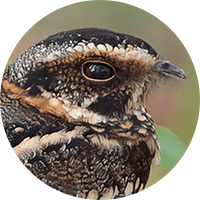Spot-tailed Nightjar
The Spot-tailed Nightjar (Hydropsalis maculicaudus) Read in Spanish
Appearance: The Spot-tailed Nightjar is a medium-sized bird with cryptic plumage that provides excellent camouflage in its habitat. It has a mottled brown and gray coloration with intricate patterns that help it blend into its surroundings. The most distinctive feature of the Spot-tailed Nightjar is the white spots or "eyes" on its tail, which are visible in flight.
Habitat: The Spot-tailed Nightjar is typically found in open habitats such as savannas, grasslands, scrublands, and forest edges. It prefers areas with sparse vegetation where it can forage for insects and raise its young. The Spot-tailed Nightjar can be found in various regions, including the Andean foothills, lowland forests, and grasslands.
Behavior: Like other nightjars, the Spot-tailed Nightjar is crepuscular and nocturnal, being most active at dawn and dusk. It hunts for insects on the wing, using its aerial agility to catch prey in flight. During the daytime, the Spot-tailed Nightjar typically roosts on the ground, relying on its cryptic plumage to remain hidden from predators.
Breeding: The breeding behavior of the Spot-tailed Nightjar involves courtship displays by males to attract females. Females lay their eggs directly on the ground without a nest, relying on their camouflage to protect the eggs from predators. Both parents are involved in incubating the eggs and caring for the young until they fledge.
Conservation Status: The Spot-tailed Nightjar is classified as "Least Concern" on the IUCN Red List.
Distribution
The Spot-tailed Nightjar (Hydropsalis maculicaudus)
Andean Region: The Spot-tailed Nightjar can be found in the Andean region of Colombia, including areas along the eastern and western slopes of the Andes. This region provides a mix of habitats such as montane forests, cloud forests, and forest edges where the Spot-tailed Nightjar may occur.
Caribbean Region: In the Caribbean region of Colombia, the Spot-tailed Nightjar can be observed in various habitats such as lowland forests, riverbanks, and grasslands. Coastal areas and scrublands in the Caribbean region also provide suitable habitats for the Spot-tailed Nightjar.
Orinoquía Region: The vast plains and savannas of the Orinoquía region in eastern Colombia offer suitable habitat for the Spot-tailed Nightjar. Open grasslands, savannas, and agricultural lands provide opportunities for the Spot-tailed Nightjar to forage and breed in this region.
Taxonomy
The Spot-tailed Nightjar (Hydropsalis maculicaudus)
- Kingdom: Animalia
- Phylum: Chordata
- Class: Aves (Birds)
- Order: Caprimulgiformes
- Family: Caprimulgidae
- Genus: Hydropsalis
- Species: Hydropsalis maculicaudus
Vocalization
The Spot-tailed Nightjar (Hydropsalis maculicaudus)
- Churring Call: The most commonly heard vocalization of the Spot-tailed Nightjar is a churring call produced by males during the breeding season. This call consists of a series of repetitive and accelerating notes that create a continuous churring sound. The churring call is often heard at dusk and dawn when the Spot-tailed Nightjar is most active.
- Whistling Calls: In addition to the churring call, Spot-tailed Nightjars may produce high-pitched whistling calls that are used in communication between individuals. Whistling calls can vary in pitch, duration, and intensity, serving different purposes in territorial defense, courtship displays, or contact calls.
- Clapping Sounds: Spot-tailed Nightjars are also known to produce clapping sounds with their wings during aerial displays or courtship rituals. These clapping sounds, generated by the rapid movement of the wings, contribute to the acoustic repertoire of the Spot-tailed Nightjar.
- Silent Flight: During active foraging flights, Spot-tailed Nightjars are capable of flying silently due to specialized wing feather structures that minimize noise. The silent flight allows the Nightjar to approach prey stealthily without alerting insects to its presence.
- Silent Roosting: While resting during the day, Spot-tailed Nightjars rely on their cryptic plumage and silent behavior to remain undetected by predators. They may adjust their posture and position on the ground to blend in with the surroundings and avoid drawing attention.



